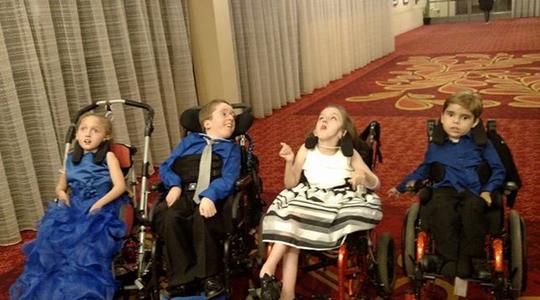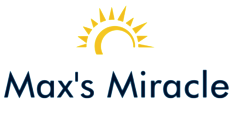
Lilliana, Max, Natalya, and Tommy
Year End Update:
2021 has been a milestone year for Canavan disease. We have two separate gene therapy trials in progress, another in the pipeline and two other teams working on preclinical testing. It's taken me twenty four years of working every day to get to this point. I could never have predicted so long ago that we'd be where we are today. This amazing progress would not have been possible without the help of thousands of people along the way. Help has come from our community, politicians both locally and on Capitol Hill, the FDA, NIH, NINDS, my own family, and other affected families who joined our mission and helped raise money to fund new projects.
Over the past twenty four years the Canavan and ultra rare disease space has grown, changed and evolved. I have learned so much, so many things I never anticipated I'd need to learn. From hosting fundraisers and family networking events, creating and running a charitable organization, becoming a grass roots lobbyist and political activist, to working with every stakeholder in the Canavan community from small start-up biotechs to huge multinational pharmaceutical companies. I was able to create and launch the world's first patient registry for Canavan disease and this in turn helped attract many new people to work on developing therapies to help our precious children. Most of this was done while caring for Maxie and my other child full-time, largely on my own. Sometimes it feels impossible to go on with this mission since Maxie's unexpected passing on April 18th, 2020, but he knew that his life and journey were an inspiration to so many people and I continue this work holding his love in my heart as motivation to push forward.
As things have evolved over the past few years my work has been focused more on patient advocacy and representing the voice of our community to people who are interested in helping our children. It has become commonplace for companies to work with advocacy organizations, so we are continually adapting our mission to best suit the direction of research and drug development for Canavan disease. And my role in this organization has evolved, grown and changed along with the Canavan space.
With so much success behind us it would be easy to slow down, or take a break from this emotionally exhausting work, but we are still years, possibly decades away from the cure. We have been able to make quality of life improvements for patients living with Canavan disease using a combination of therapies. Some children will age out of eligibility for gene therapy which has shown some potential to help slow progression of the disease and improve the quality of life for patients. Watching children age out of being candidates for gene therapy is absolutely heartbreaking for me. I wholeheartedly believe there is sufficient data to show that gene therapy can help some patients living with Canavan disease, but with with that being said it is time to move beyond gene therapy and aggressively search for teams working on other novel approaches. After twenty seven years and several different technologies, gene therapy is still not delivering the results that look like it alone could be the cure. I fully support gene therapy because it seems to help, but looking at the clinical results in patients treated anywhere from several years to eight months ago the outcome as of now is extremely underwhelming. I went through two separate gene therapy trials with my own son and he showed some improvement, and I am thrilled for anyone fortunate enough to be able to get this treatment for their children. Unfortunately it's not even close to being a cure, and after twenty seven years the research doesn't appear to have made much meaningful progress as it pertains to improvements in treated patients. Gene therapy does appear to help and cures can take several decades to develop, but they can also involve a combined approach. If gene therapy alone will not move us towards a cure, and personally I don't believe it is enough, we need to look at other options. Putting all your eggs in one basket is never the best approach. So while we have at least five or six teams that I know of working on clinical trials, or moving towards the clinic, they are all using different types of gene therapy. You can only reinvent a broken wheel so many times before saying "maybe this is not the miracle we hoped for, or perhaps we need to look beyond gene therapy." Sometimes we get so close and personally attached to a project after investing decades of our life and millions of dollars it can become our sole focus because we believe in it so much, and we want it to work so badly that we blindly direct a majority of our resources to it. It's hard to move past something we want and believe in so much, but those emotions can make it hard to see the bigger picture. And at that point we need to take a giant step back and start looking at other options.
We are possibly missing a huge part of the Canavan puzzle. I have spoken with other teams and no one can say for sure whether another gene could be mutated, or contributing to disease progression. After identifying the ASPA mutation on chromosome 17 we have focused solely on that one gene. There are types of cancer that have several genes involved. It is time to take that step back and study the pathology of Canavan disease. We need to look more closely at this disease outside the scope of testing different gene therapy models on mice and children. We need to find the missing pieces of this puzzle. We have already cured hundreds of mice with gene therapy, but not one single child.
My hope is that one of the ongoing trials will still surprise me and deliver a more meaningful result than anticipated, but I will not gamble the lives of our children on that hope. The next phase of my mission will focus on directing funds to teams working on studying the pathology of Canavan disease and finding methods to treat it beyond replacing a single gene. I will continue to support every team and stakeholder working on gene therapy, even new ones, but it's time to expand our efforts to find the cure in whatever form it may take. I have also been actively involved in helping to develop a newborn screen for Canavan disease over the past few years. With more treatment options becoming available it is more critical than ever before to diagnose patients at birth and hopefully get them enrolled in clinical trials earlier to maximize the treatment I will update as more information becomes available about the newborn test.
I thank each and every person who has stood by me for so long and I look forward to paving the way as I direct funding into new areas of research and explore anything and everything that shows promise to help our children. And I will never forget the older patients. Canavan is an aging population with many kids already well into adulthood and those patients are just as important to me as newly diagnosed babies. My son passed away six months before his twenty third birthday and even with all my work his last treatment was at three years of age. I feel in many ways like I let him down. This is a very personal mission for me. And Maxie's memory and love give me the strength, inspiration and courage to move forward and make my way through new and uncharted territory as I continue to search in every direction for the cure. We accept grant requests all year long and have an ongoing RFP (request for proposals) from any team working on Canavan disease, whether it's studying the disease or gathering pre-clinical data. We are always looking for projects that need funding or seed money. Please feel free to share this information, or let me know if you hear of any research in need of funding. We do our best to search for projects, but it's not always possible to locate every team or lab in need of funding. I am always happy to reach out to them personally and see if they need funding to move forward more quickly, or if they're willing and able to apply their work on a related disease to Canavan. A personal request and offer of funding is how many teams begin working on new diseases. It never hurts to make that plea on behalf of our beautiful children.
To learn more about Canavan disease and our mission, or to make a donation to help us search for the cure please contact me at ilyce@canavanresearch.org or visit www.CureCanavan.org.
With peace and gratitude,
Ilyce Randell
Director of Patient Advocacy and Cofounder
Canavan Research Illinois/Canavan Disease Research
#CureCanavan



